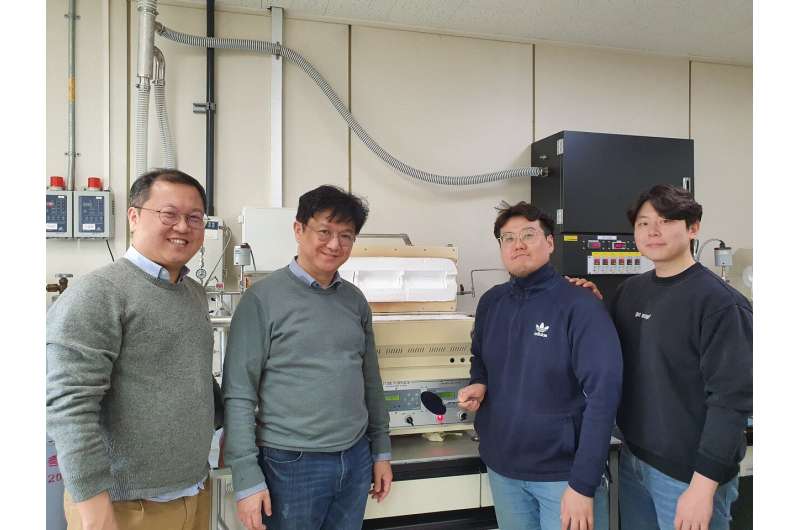February 24, 2020 feature
Large-area electronic-grade graphene grows on the cheap

The electronics industry might look very different today were it not for the dramatic drop in cost of high-quality single-crystalline silicon wafers over the past five decades. So what would happen if the cost of single-crystalline graphene took a similarly significant plunge? Results reported in ACS Nano may bring this closer to reality, as they show that single-crystalline graphene can grow in a fraction of the usual time and using much cheaper polycrystalline substrates than usually needed.
The costs of producing graphene have already dropped substantially over the past 20 years from hundreds of thousands of dollars per kilogram to less than $50. However, exploiting the material's electronic properties places much higher requirements on the crystal quality—grain boundaries, defects and dislocations all disrupt the material's electronic behavior—so that the price tag for electronics-grade graphene remains high.
Chemical vapor deposition is among the most popular approaches to grow good-quality graphene, but defects are inevitable. Tinkering with the parameters during growth so that no additional nucleation sites form can foster the growth of single crystalline graphene, eventually. However, the long period of time this growth takes makes it costly. Other approaches include growth on a single-crystalline catalytic substrate, but these substrates are more expensive, again ramping up the cost.
Instead, Dongmok Whang at Sungkyunkwan University Advanced Institute of Nanotechnology and Jae-Hyun Lee at Ajou University and their colleagues have taken some single-crystal graphene and transferred pieces of it spaced out on a polycrystalline substrate. They show in their report that subsequently growing the pieces on the polycrystalline metals allows them to join up. Because they have all been transferred from the same sample, the crystal lattice of each piece is oriented in the same direction, leaving no grain boundaries. "If the synthesis temperature, gas used, etc. are assumed to be similar, the thermal budget and the price of the substrate can be said to be reduced to a quarter," explains Lee.
Seamless growth
Lee explains that they came up with the idea after a preliminary literature survey highlighted that the energy required to grow the graphene from the edge of the graphene seed is theoretically lower than the energy required for nucleation of new graphene seeds. "In other words, it was thought that additional nucleation could be easily suppressed at lower energy conditions (e.g., low concentration of precursor or low growth temperature)."
Whang and Lee and colleagues also had a head start in getting the process to work. Their seeded growth process hinges on access to large-area single-crystal monolayer graphene, which they were well experienced in growing. In addition, they needed a technique capable of cleanly transferring the aligned seeds to carefully spaced and aligned positions on the polycrystalline substrate. Fortunately, they had also previously demonstrated that when growing graphene on a particular facet of single-crystalline germanium—Ge(110)—a hydrogen layer formed at the interface between the graphene and substrate, making it easier to transfer.
Even with transfer from Ge(110), defects inevitably creep in, but the researchers were also able to show that by reducing the methane for a period during growth, the etch rate could exceed the growth rate so that existing defects could be etched away.
Electronic grade graphene
To determine what seed size and spacing would work best, Whang and Lee and colleagues calculated the diffusion length for the temperatures and precursor concentrations used. They cut "seeds" 10 μm wide from their original single-crystalline graphene sample and transferred them to polycrystalline platinum spaced 50 μm apart. Here, they grew single-crystalline graphene to cover an area of 2 cm x 2 cm."It was difficult to grow to larger sizes due to the limitations of our CVD system," says Lee. "But we believe that our approach can be fully applied to large catalyst substrate."
Not only is polycrystalline platinum much cheaper but they could recycle the substrate without damaging the quality of the resulting single-crystalline graphene so that it works out at around $100 dollars per cm2 of substrate instead of $2000. They expect that if they can grow the transferred seeds on polycrystalline copper or aluminum foil, they will be able to cut the costs further still.
The researchers tested the electronic properties of graphene grown from transferred seeds by constructing field effect transistor devices that straddled the sites of two transferred seeds. Comparisons of the electron mobility showed no appreciable drop in mobility where the transferred seeds joined, giving 11,811 V cm-1 s-1 for the left grain, 10,844 for the right and 11,063 V cm-1 s-1 between them.
Other 2-D materials?
The researchers tried out the idea with graphene because its growth behavior is well understood, and in particular, it is only made of one atom type, carbon, which simplifies the process. They would like to apply the approach to 2-D materials, but would need to look into how they manage the different precursors for non-elemental 2-D materials.
"There are many variables to consider because of the different solubility and diffusion rates of each element in the catalyst," says Lee. "However, if we use a process that sequentially reacts one precursor and another precursor, such as an atomic layer deposition (ALD) process, which can simplify process parameters, it could be possible to grow a single crystalline monolayer of various 2-D materials."
More information: Hyeon-Sik Jang et al. Toward scalable growth for single-crystal graphene on polycrystalline metal foil, ACS Nano 2020. DOI: 10.1021/acsnano.9b08305
Journal information: ACS Nano
© 2020 Science X Network




















